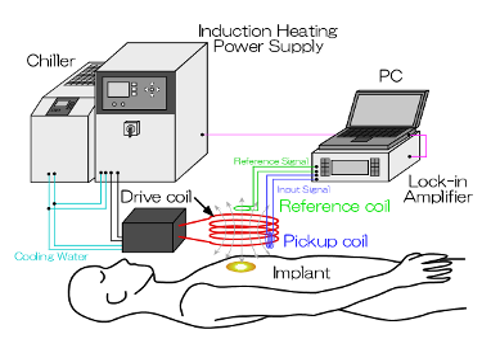Significance of Hyperthermia
Cancer is the leading cause of death in Japan, claiming 370,000 precious lives every year.
We focused on hyperthermia, a treatment for cancer that utilizes the thermosensitivity of cancer cells (Figure 1), which is different from that of normal cells. Hyperthermia has fewer side effects than radiation therapy, anticancer drug therapy, or surgery, and its effectiveness can be enhanced when used in combination with these therapies. Hyperthermia is expected to be a promising method for terminal cancer patients to live the rest of their lives with a high quality of life.
This research employs magnetic hyperthermia, in which fine particles of thermosensitive magnetic material (magnetic material that loses its magnetism when it reaches the Curie point* [Figure 2]) are injected into the tumor site and heated by induction with a high-frequency magnetic field from outside the body to heat the malignant tumor at a constant temperature. We have developed a Wireless Temperature Monitoring System that detects whether or not the target treatment temperature has been reached by detecting changes in the magnetic field near the Curie point as induced electromotive force of a pickup coil installed on the body surface.
*In, this study, the Curie point is set 45 ℃.

Figure 1. Differences in heat sensitivity between normal cells and cancer cells

Figure 2. Features of temperature-sensitive magnetic materials
Schematic diagram of Wireless Temperature Monitoring System

About Wireless Temperature Monitoring System
① High-frequency current (128 to 400 kHz) is applied to the drive coil to generate a high-frequency magnetic field.
② The change in the magnetic flux penetrating the pickup coil is detected as induced electromotive force.
③ The induced electromotive force is detected synchronously with the high-frequency magnetic field using a lock-in amplifier and automatically measured in LabVIEW.
About LabVIEW
LabVIEW is a programming language for creating software to acquire, analyze, and display data from various measurement devices. In addition to industry, LabVIEW has also been adopted by many research institutes and universities in the field of education and research.
LabVIEW is a programming language that allows you to work visually. It is easy to use, even for beginners, and can be easily programmed as if it were a drawing.


Figure 3. Program example (left), execution result (right)


